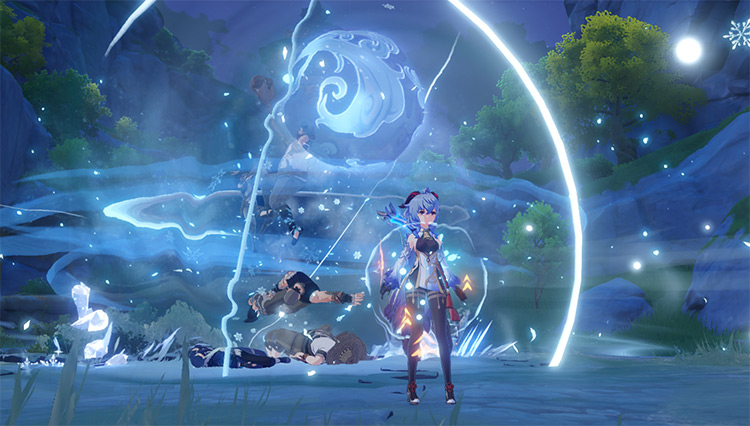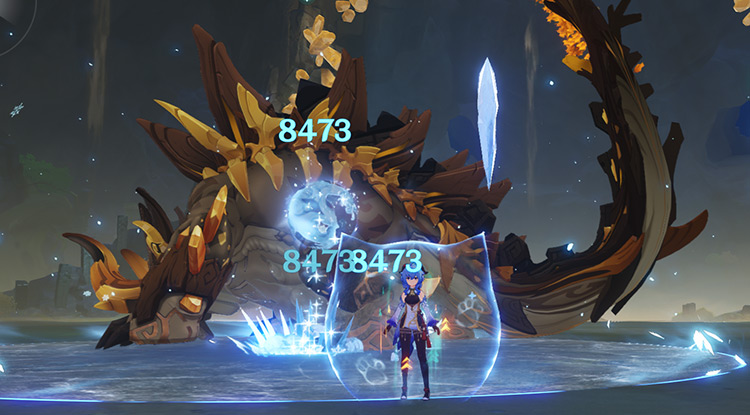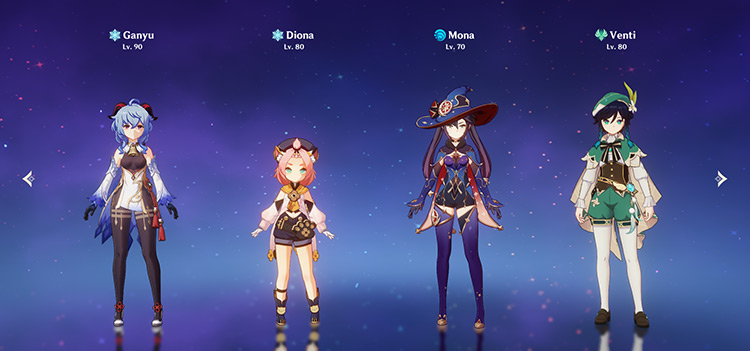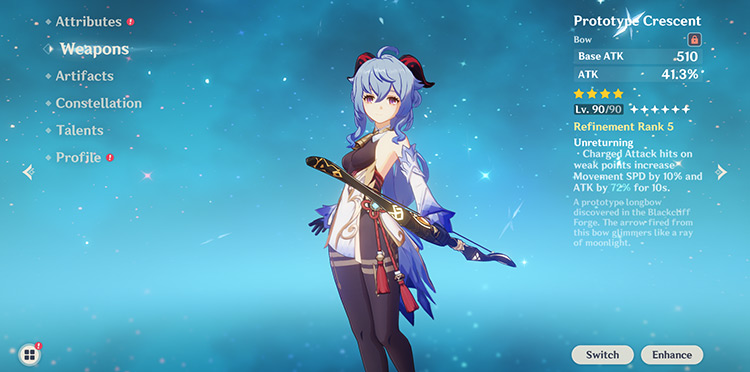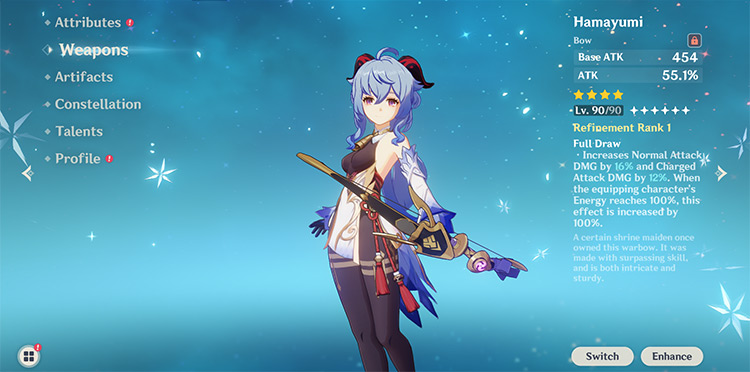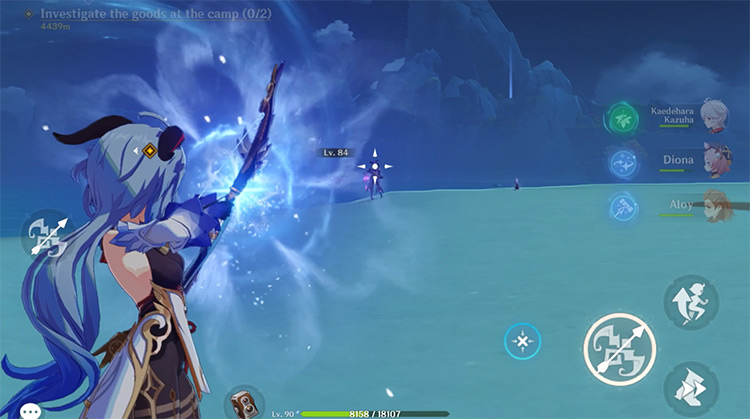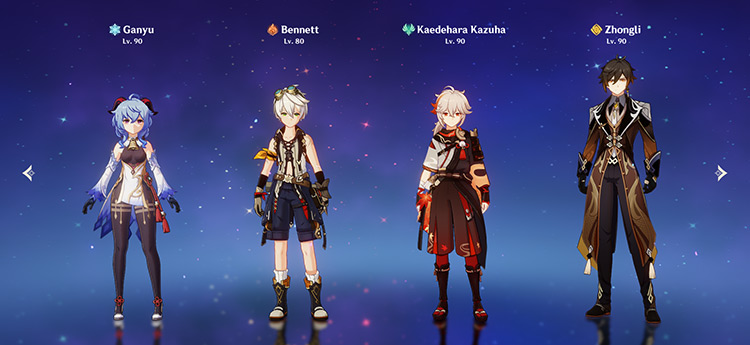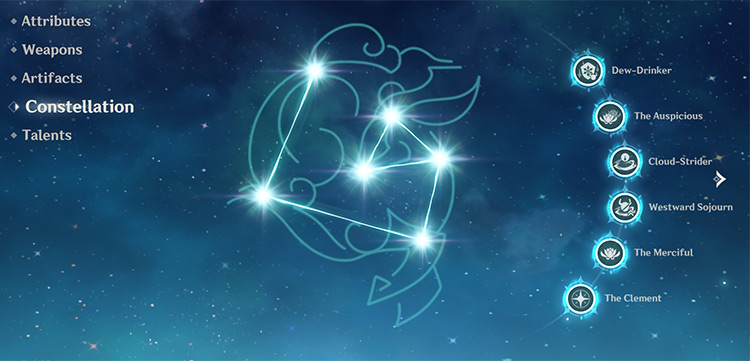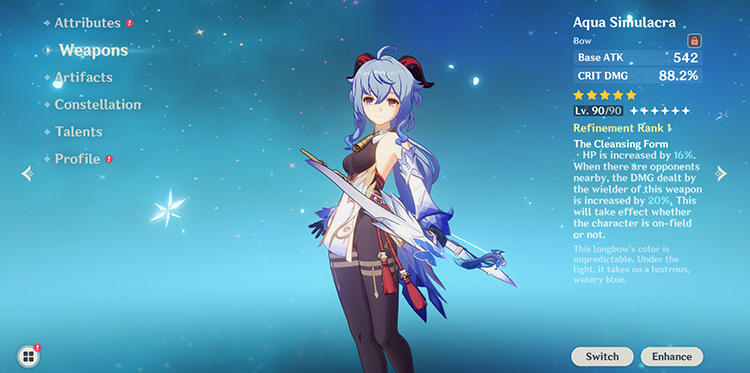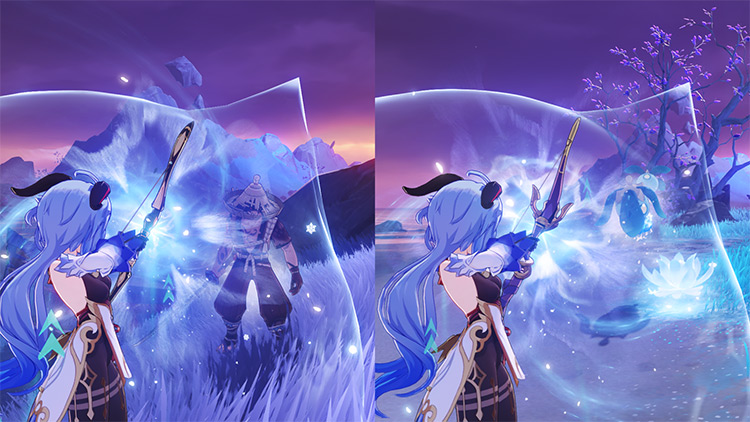She’s a very flexible unit that has a wide variety of playstyles. The most notable ones are an On-Field DPS, Off-Field DPS, and Cryo Support. This lets her form multiple team comps that can adapt to almost any content she faces. Her special charged attacks also aren’t easily debuffed by issues like energy or cooldown extension. Plus, she has an equally strong burst that works for both damage and support. Ganyu’s basically a great unit at any point in the game – both in the overworld and Spiral Abyss. She only loses some pull value if you already have Ayaka. They’re both strong Cryo DPS units, and having one of them is often enough for an account. Still, you can’t go wrong with just having both of them – they do excel at different things. Note: This is based on meta only. If you like Ganyu regardless of her power level, don’t let this stop you from pulling her.
Pros & Cons
Ganyu Strengths
Ganyu’s strong charged attacks aren’t affected by energy restraints and cooldown extension debuffs. This makes her especially good against content that has these restrictions – most notably the Slowing Waters debuff. This increases the affected character’s cooldowns and can easily ruin most teams’ rotations. But aside from Ganyu’s charged attacks, her burst is still pretty important. It deals a sizable portion of her damage. So in teams where you can cast her burst, it’s highly recommended for you to use it – it’s just a really strong ability. Ganyu’s burst is a powerful ability that deals a significant amount of damage – and even provides a 20% Cryo damage bonus. It has a 15s duration with a 15s cooldown. So with enough Energy Recharge, it’s very easy to get full uptime. Throughout her burst’s duration, it summons 50 icicles. Against 5 or fewer opponents, at least 10 icicles will hit one target per burst. And against more than 5 opponents, the distribution of icicles will be random – but all 50 icicles are guaranteed to hit. Each icicle also covers a small AOE that can hit multiple opponents at once. So by using a grouper to gather opponents together, each icicle can hit multiple targets simultaneously and significantly increase Ganyu’s total DPS. This is basically what makes Venti a remarkable Ganyu teammate against AOE content. Plus, her burst is also great against single-target with larger hitboxes. This is simply because most of her icicles will very likely hit that single big target. A great example of this is Azdaha. Thanks to his enormous hitbox, it’s very easy for all 50 icicles to hit him. Ganyu can fulfill three different roles – namely, an On-field DPS, Off-field DPS, and Cryo Support. All of these have different playstyles and often different builds. Each one excels against different types of content. It basically lets you choose a Ganyu playstyle that best suits you or the enemies you’re facing. Here’s a more detailed description of each playstyle. Prototype Crescent is a Mondstadt craftable bow that synergizes extremely well with Ganyu. Its stats and passive mainly provide a lot of ATK. This is especially valuable in Freeze teams since Ganyu tends to already have a lot of CRIT stats and less ATK. And it grows even stronger with refinements. At R5, its passive’s ATK buff is increased to 72%. With this, it can even outperform some 5-star weapons. Plus, it’s easier to get Prototype refinements since it is a craftable weapon. Another great F2P-friendly option is Hamayumi – the Inazuma craftable bow. Since not every opponent has a weakspot, Hamayumi is a great alternative for Prototype Crescent. It’s also a craftable weapon, so it’s relatively easy to get refinements.
Ganyu Weaknesses
As an On-field DPS, Ganyu’s special charged attacks (CA) deal a significant portion of her total DPS. Although her CA’s cover a larger AOE, you still need to hit an opponent or object with the initial smaller attack. This can be challenging for some players – especially for those that use the mobile or Playstation platform. Missing charged attacks can be a sizable damage loss. In such cases, it’s often recommended to go for the Burst DPS playstyle – or just go for Ayaka. Bow and catalyst users are twice more easily staggered than other units. This is innate in their game code, and it can be a problem for units that spend a lot of field time. This is especially true for an On-field DPS Ganyu. In Freeze teams, this is often not an issue since opponents are frozen anyway. It’s only very noticeable in Melt teams. Ganyu can easily get interrupted during her charged attacks, thus effectively canceling the attack. This is a sizable damage loss. So it’s very important to use a shield in her Melt teams – most notably Zhongli.
Are Ganyu’s Constellations Good?
Ganyu has pretty good constellations. She’s already a powerful unit at C0, so there’s absolutely no need for constellations. They’re mainly damage and quality-of-life (QoL) buffs – they don’t change any of her playstyles from C0. But if you insist on pulling, C1 is the best place to stop. It’s a great damage boost that outshines most of her early constellations. She does have other great constellations (C4 & C6), but pulling for them simply isn’t cost-effective. It’s far better to just pull for other units. Still, here’s a closer look at each one of her constellations if you plan on pulling past C1.
C1: Dew-Drinker
Ganyu’s FrostFlake Arrow and Blooms decrease opponents’ Cryo resistance by 15% for 6s upon hit. A hit also regenerates 2 Energy for Ganyu. This can only be triggered once per Frostflake Arrow, regardless if the arrow itself or its Bloom hits the target. The Cryo resistance shred directly buffs Ganyu’s damage – and even other Cryo DPS units in the team if you have any. The energy regeneration effect is mainly a QoL buff. It helps Ganyu charge her burst faster. It’s useful for teams where Ganyu spams her burst, but it’s irrelevant for Melt teams – Ganyu doesn’t use her burst here.
C2: The Auspicious
Increases her skill charge by 1. C2 is a very underwhelming constellation before C6. The extra energy particles generated from Ganyu’s 2nd skill mainly help charge her burst. Since Ganyu already has a relatively low Energy Requirement – which is further decreased by C1 – these extra particles are unnecessary. The 2nd taunt can occasionally be useful, but taunts in Genshin are often unreliable. They don’t really work most of the time.
C3: Cloud-Strider
Increases her elemental burst talent by 3. This increases Ganyu’s burst multipliers – it serves as a decent damage gain.
C4: Westward Sojourn
Opponents inside Ganyu’s burst take increased damage. Increased damage taken starts at 5% and increases every 3s – up to a maximum of 25%. This effect lingers for 3s after the opponent leaves her burst. The increased damage effect also counts for damage dealt by teammates, so it also benefits the entire team. This is a great constellation for every Ganyu team except Melt – her burst isn’t used in this team.
C5: The Merciful
Increases her elemental skill talent by 3. It’s a pretty bad constellation. Her skill deals a very small portion of her damage, so C5’s damage gain is insignificant. This constellation is considered more of a stepping stone for C6.
C6: The Clement
Using Ganyu’s skill causes the next Frostflake Arrow shot within 30s to not require charging. This is a really strong constellation. It effectively removes her Frostflake Arrow’s charging time for 2-3 attacks per rotation. It also retroactively makes her C1 and C2 better.
Amos’ Bow vs. Aqua Simulacra for Ganyu
Aqua Simulacra is slightly better than Amos’ Bow for Ganyu – but the gap is very small (only around ~2%). Because of this, the better weapon will very often depend on your artifacts and teams. It’s highly recommended to just use whichever one you have available. Don’t pull for Aqua if you already have Amos’ – and vice versa.
Prototype Crescent vs. Hamayumi for Ganyu
Generally, Prototype Crescent is considered the better option. But its passive is all or nothing – either you hit a weakspot or don’t. And the damage difference between those two scenarios is pretty significant. Whereas, Hamayumi is more for general usage. You’ll always benefit from its passive – sometimes more than others. Basically, one can situationally outperform the other. Both weapons have conditional passives which are strong in some scenarios but useless in others. Here’s a more detailed ranking for each scenario:

